sensor BMW X5 2004 E53 Central Body Electronics Workshop Manual
[x] Cancel search | Manufacturer: BMW, Model Year: 2004, Model line: X5, Model: BMW X5 2004 E53Pages: 64, PDF Size: 4.03 MB
Page 1 of 64
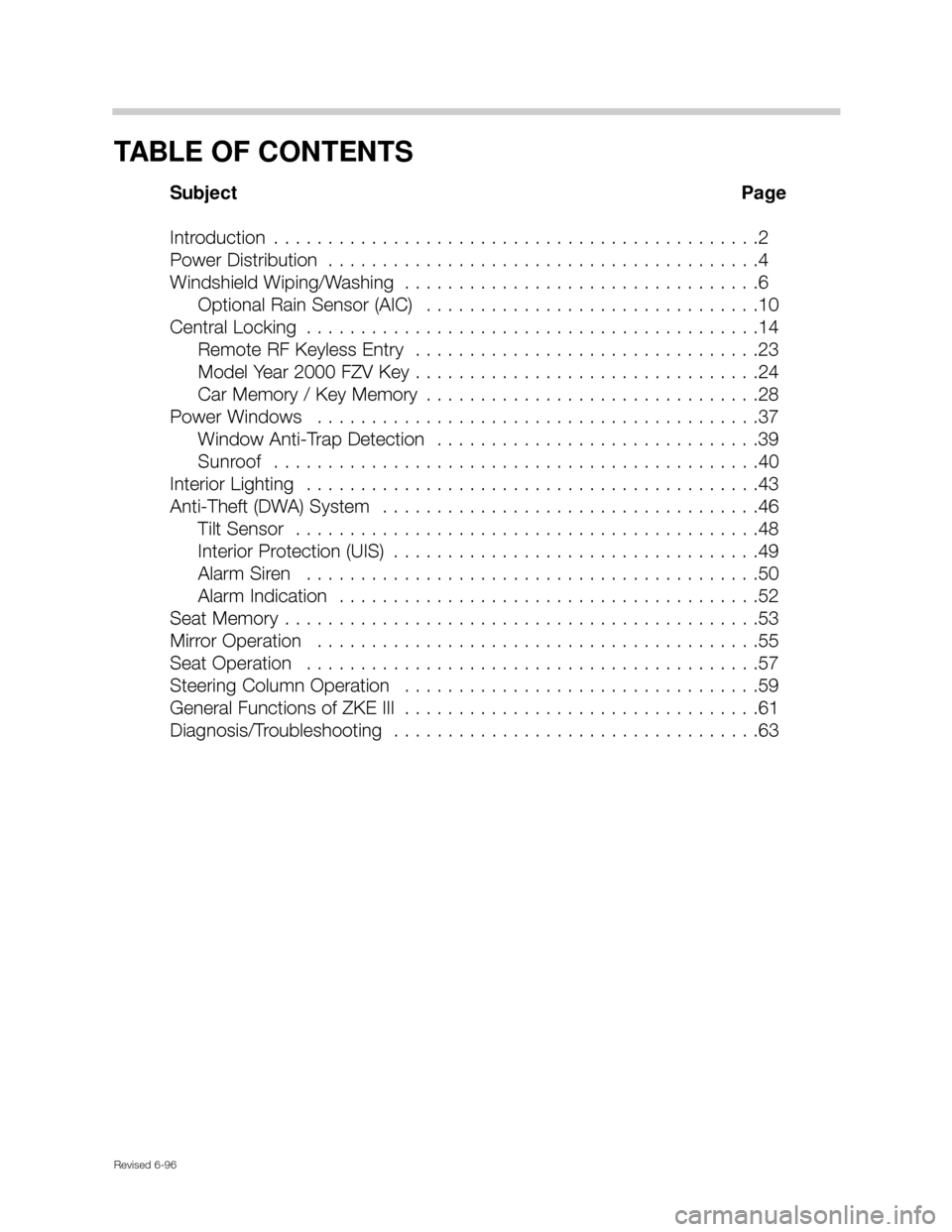
TABLE OF CONTENTS
Subject Page
Introduction . . . . . . . . . . . . . . . . . . . . . . . . . . . . . . . . . . . . . . . . . . . . .2
Power Distribution . . . . . . . . . . . . . . . . . . . . . . . . . . . . . . . . . . . . . . . .4
Windshield Wiping/Washing . . . . . . . . . . . . . . . . . . . . . . . . . . . . . . . . .6
Optional Rain Sensor (AIC) . . . . . . . . . . . . . . . . . . . . . . . . . . . . . . .10
Central Locking . . . . . . . . . . . . . . . . . . . . . . . . . . . . . . . . . . . . . . . . . .14
Remote RF Keyless Entry . . . . . . . . . . . . . . . . . . . . . . . . . . . . . . . .23
Model Year 2000 FZV Key . . . . . . . . . . . . . . . . . . . . . . . . . . . . . . . .24
Car Memory / Key Memory . . . . . . . . . . . . . . . . . . . . . . . . . . . . . . .28
Power Windows . . . . . . . . . . . . . . . . . . . . . . . . . . . . . . . . . . . . . . . . .37
Window Anti-Trap Detection . . . . . . . . . . . . . . . . . . . . . . . . . . . . . .39
Sunroof . . . . . . . . . . . . . . . . . . . . . . . . . . . . . . . . . . . . . . . . . . . . .40
Interior Lighting . . . . . . . . . . . . . . . . . . . . . . . . . . . . . . . . . . . . . . . . . .43
Anti-Theft (DWA) System . . . . . . . . . . . . . . . . . . . . . . . . . . . . . . . . . . .46
Tilt Sensor . . . . . . . . . . . . . . . . . . . . . . . . . . . . . . . . . . . . . . . . . . .48
Interior Protection (UIS) . . . . . . . . . . . . . . . . . . . . . . . . . . . . . . . . . .49
Alarm Siren . . . . . . . . . . . . . . . . . . . . . . . . . . . . . . . . . . . . . . . . . .50
Alarm Indication . . . . . . . . . . . . . . . . . . . . . . . . . . . . . . . . . . . . . . .52
Seat Memory . . . . . . . . . . . . . . . . . . . . . . . . . . . . . . . . . . . . . . . . . . . .53
Mirror Operation . . . . . . . . . . . . . . . . . . . . . . . . . . . . . . . . . . . . . . . . .55
Seat Operation . . . . . . . . . . . . . . . . . . . . . . . . . . . . . . . . . . . . . . . . . .57
Steering Column Operation . . . . . . . . . . . . . . . . . . . . . . . . . . . . . . . . .59
General Functions of ZKE III . . . . . . . . . . . . . . . . . . . . . . . . . . . . . . . . .61
Diagnosis/Troubleshooting . . . . . . . . . . . . . . . . . . . . . . . . . . . . . . . . . .63
Revised 6-96
Page 2 of 64
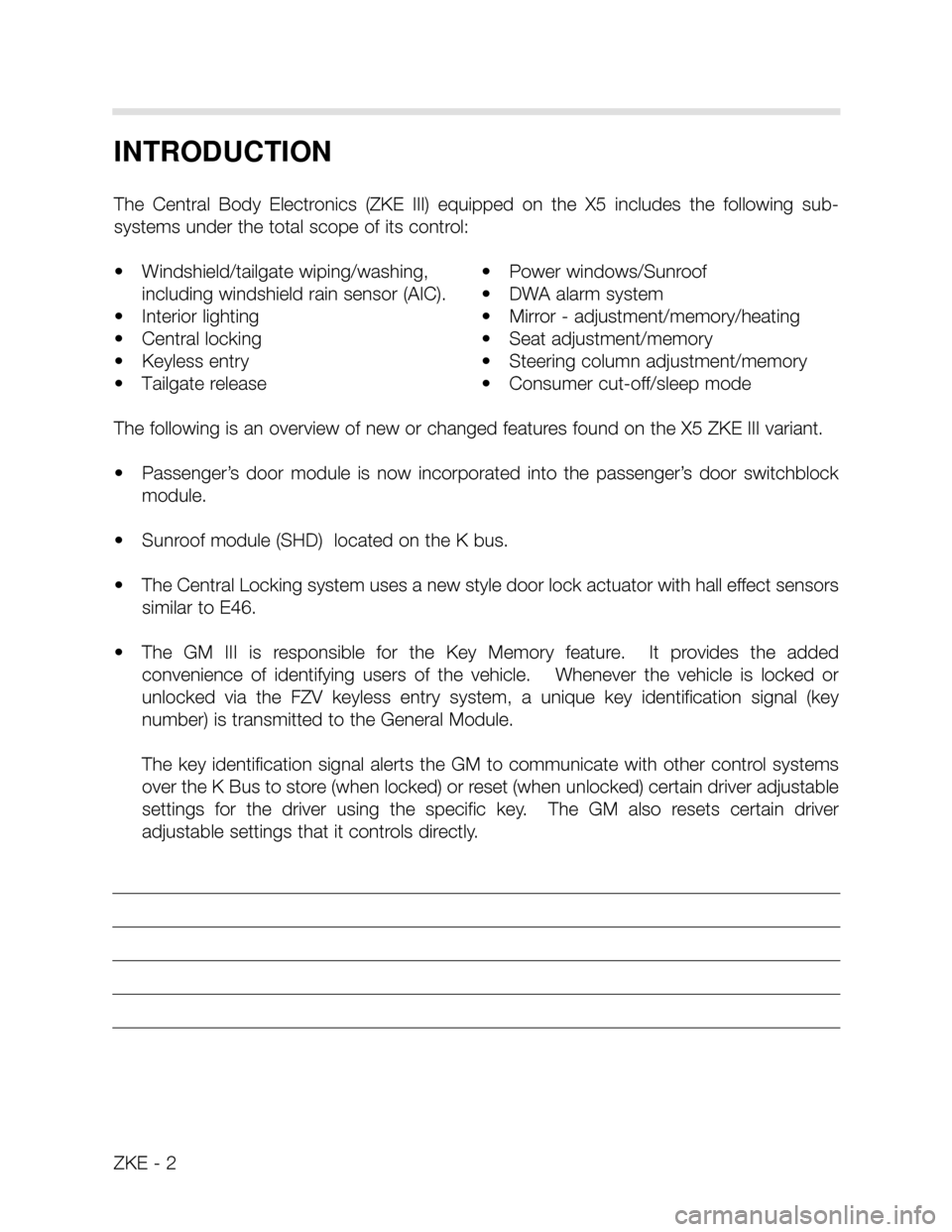
INTRODUCTION
The Central Body Electronics (ZKE III) equipped on the X5 includes the following sub-
systems under the total scope of its control:
• Windshield/tailgate wiping/washing,
including windshield rain sensor (AIC).
• Interior lighting
• Central locking
• Keyless entry
• Tailgate release
The following is an overview of new or changed features found on the X5 ZKE III variant.
• Passenger’s door module is now incorporated into the passenger’s door switchblock
module.
• Sunroof module (SHD) located on the K bus.
• The Central Locking system uses a new style door lock actuator with hall effect sensors
similar to E46.
• The GM III is responsible for the Key Memory feature. It provides the added
convenience of identifying users of the vehicle. Whenever the vehicle is locked or
unlocked via the FZV keyless entry system, a unique key identification signal (key
number) is transmitted to the General Module.
The key identification signal alerts the GM to communicate with other control systems
over the K Bus to store (when locked) or reset (when unlocked) certain driver adjustable
settings for the driver using the specific key. The GM also resets certain driver
adjustable settings that it controls directly.
• Power windows/Sunroof
• DWA alarm system
• Mirror - adjustment/memory/heating
• Seat adjustment/memory
• Steering column adjustment/memory
• Consumer cut-off/sleep mode
ZKE - 2
Page 6 of 64
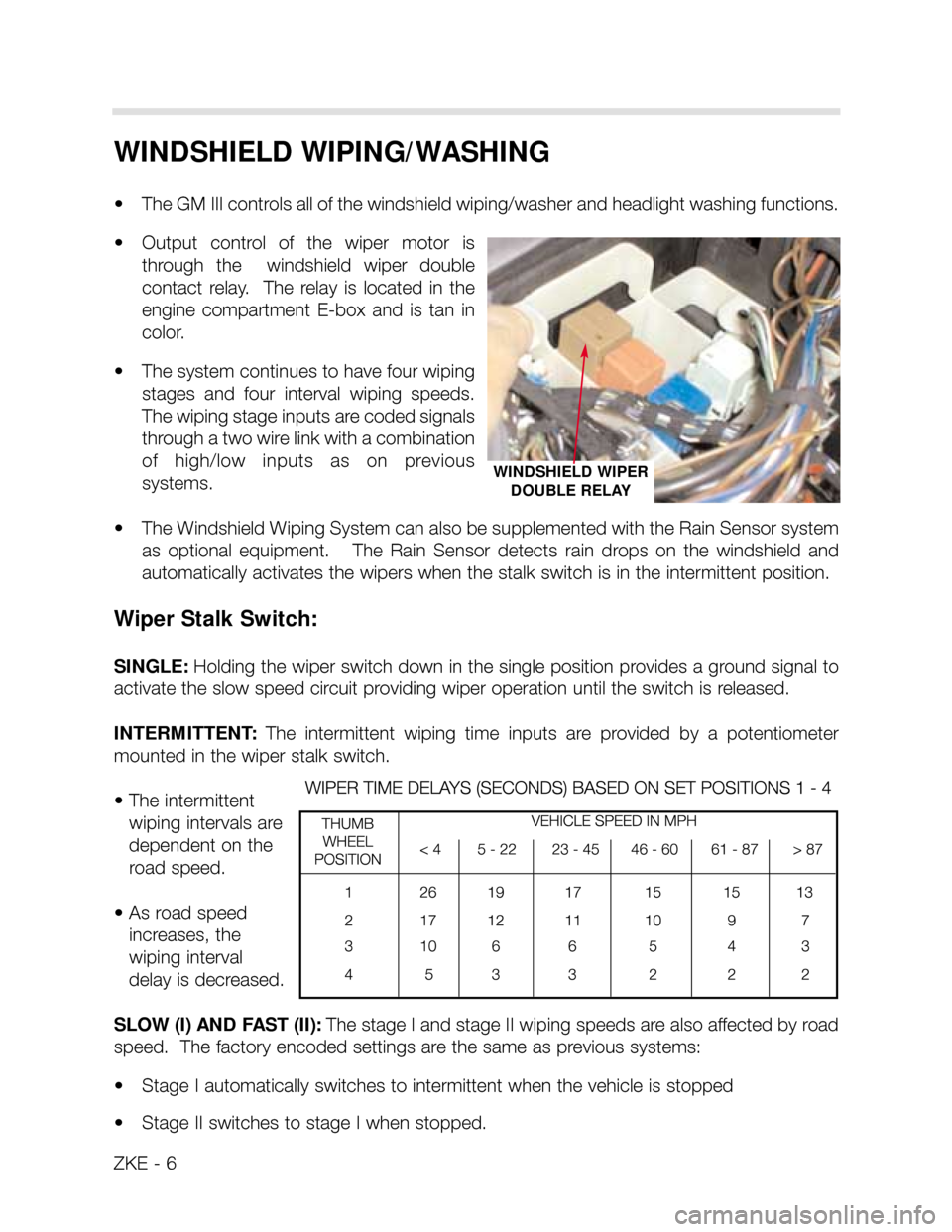
WINDSHIELD WIPING/WASHING
• The GM III controls all of the windshield wiping/washer and headlight washing functions.
• Output control of the wiper motor is
through the windshield wiper double
contact relay. The relay is located in the
engine compartment E-box and is tan in
color.
• The system continues to have four wiping
stages and four interval wiping speeds.
The wiping stage inputs are coded signals
through a two wire link with a combination
of high/low inputs as on previous
systems.
• The Windshield Wiping System can also be supplemented with the Rain Sensor system
as optional equipment. The Rain Sensor detects rain drops on the windshield and
automatically activates the wipers when the stalk switch is in the intermittent position.
Wiper Stalk Switch:
SINGLE: Holding the wiper switch down in the single position provides a ground signal to
activate the slow speed circuit providing wiper operation until the switch is released.
INTERMITTENT: The intermittent wiping time inputs are provided by a potentiometer
mounted in the wiper stalk switch.
• The intermittent
wiping intervals are
dependent on the
road speed.
• As road speed
increases, the
wiping interval
delay is decreased.
SLOW (I) AND FAST (II): The stage I and stage II wiping speeds are also affected by road
speed. The factory encoded settings are the same as previous systems:
• Stage I automatically switches to intermittent when the vehicle is stopped
• Stage II switches to stage I when stopped.
ZKE - 6
WINDSHIELD WIPER
DOUBLE RELAY
Page 9 of 64
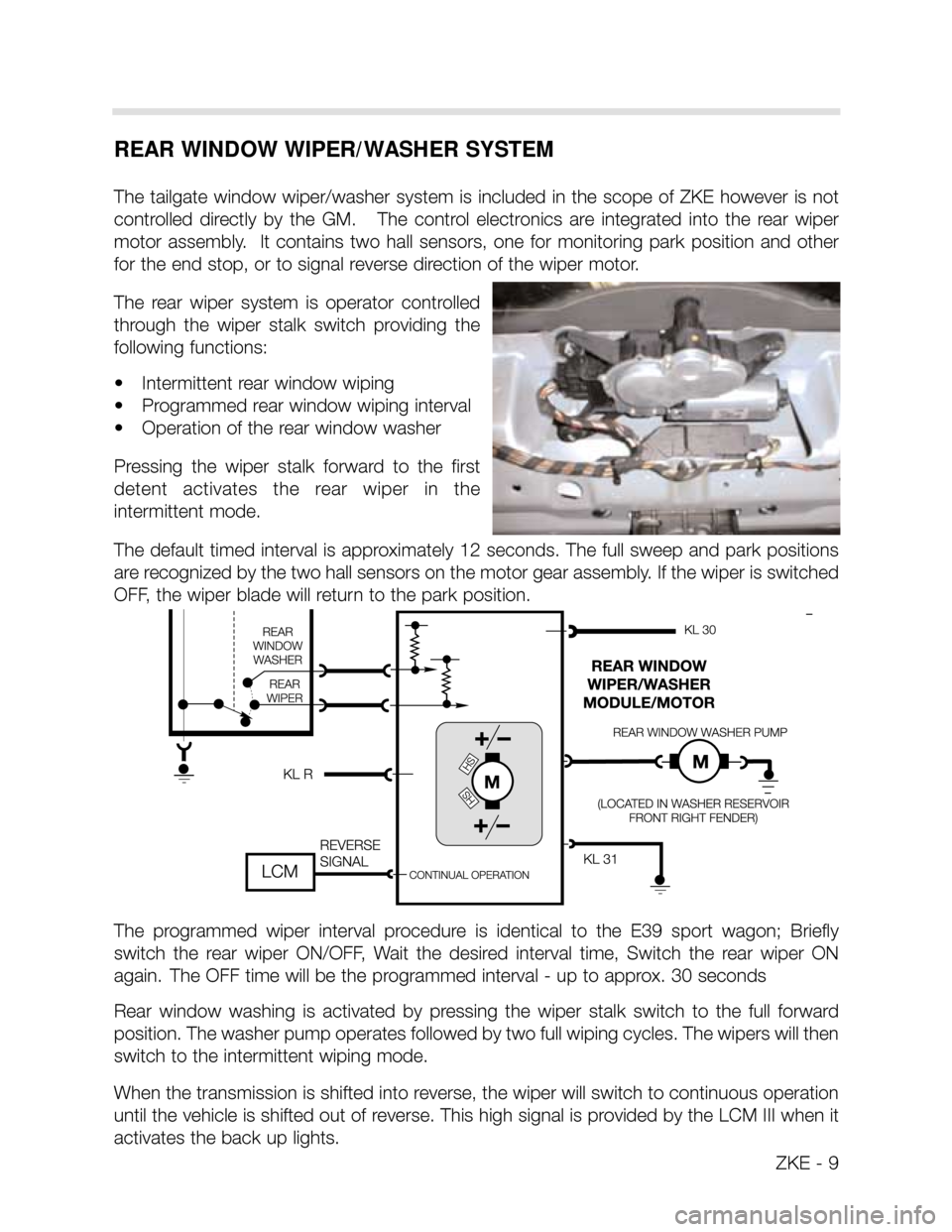
REAR WINDOW WIPER/WASHER SYSTEM
The tailgate window wiper/washer system is included in the scope of ZKE however is not
controlled directly by the GM. The control electronics are integrated into the rear wiper
motor assembly. It contains two hall sensors, one for monitoring park position and other
for the end stop, or to signal reverse direction of the wiper motor.
The rear wiper system is operator controlled
through the wiper stalk switch providing the
following functions:
• Intermittent rear window wiping
• Programmed rear window wiping interval
• Operation of the rear window washer
Pressing the wiper stalk forward to the first
detent activates the rear wiper in the
intermittent mode.
The default timed interval is approximately 12 seconds. The full sweep and park positions
are recognized by the two hall sensors on the motor gear assembly. If the wiper is switched
OFF, the wiper blade will return to the park position.
The programmed wiper interval procedure is identical to the E39 sport wagon; Briefly
switch the rear wiper ON/OFF, Wait the desired interval time, Switch the rear wiper ON
again. The OFF time will be the programmed interval - up to approx. 30 seconds
Rear window washing is activated by pressing the wiper stalk switch to the full forward
position. The washer pump operates followed by two full wiping cycles. The wipers will then
switch to the intermittent wiping mode.
When the transmission is shifted into reverse, the wiper will switch to continuous operation
until the vehicle is shifted out of reverse. This high signal is provided by the LCM III when it
activates the back up lights.
ZKE - 9
Page 10 of 64
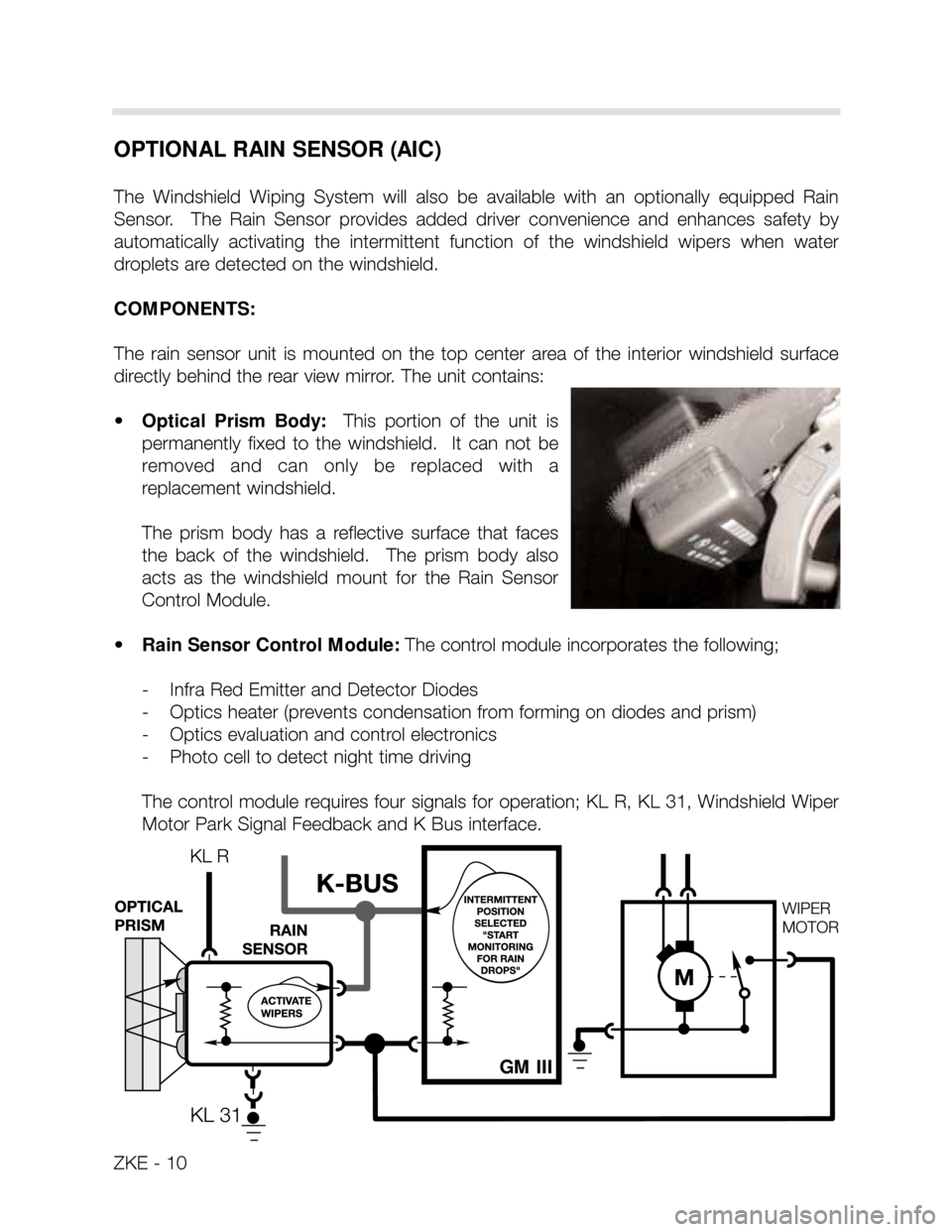
OPTIONAL RAIN SENSOR (AIC)
The Windshield Wiping System will also be available with an optionally equipped Rain
Sensor. The Rain Sensor provides added driver convenience and enhances safety by
automatically activating the intermittent function of the windshield wipers when water
droplets are detected on the windshield.
COMPONENTS:
The rain sensor unit is mounted on the top center area of the interior windshield surface
directly behind the rear view mirror. The unit contains:
•Optical Prism Body:This portion of the unit is
permanently fixed to the windshield. It can not be
removed and can only be replaced with a
replacement windshield.
The prism body has a reflective surface that faces
the back of the windshield. The prism body also
acts as the windshield mount for the Rain Sensor
Control Module.
•Rain Sensor Control Module:The control module incorporates the following;
- Infra Red Emitter and Detector Diodes
- Optics heater (prevents condensation from forming on diodes and prism)
- Optics evaluation and control electronics
- Photo cell to detect night time driving
The control module requires four signals for operation; KL R, KL 31, Windshield Wiper
Motor Park Signal Feedback and K Bus interface.
ZKE - 10
GM III
Page 11 of 64
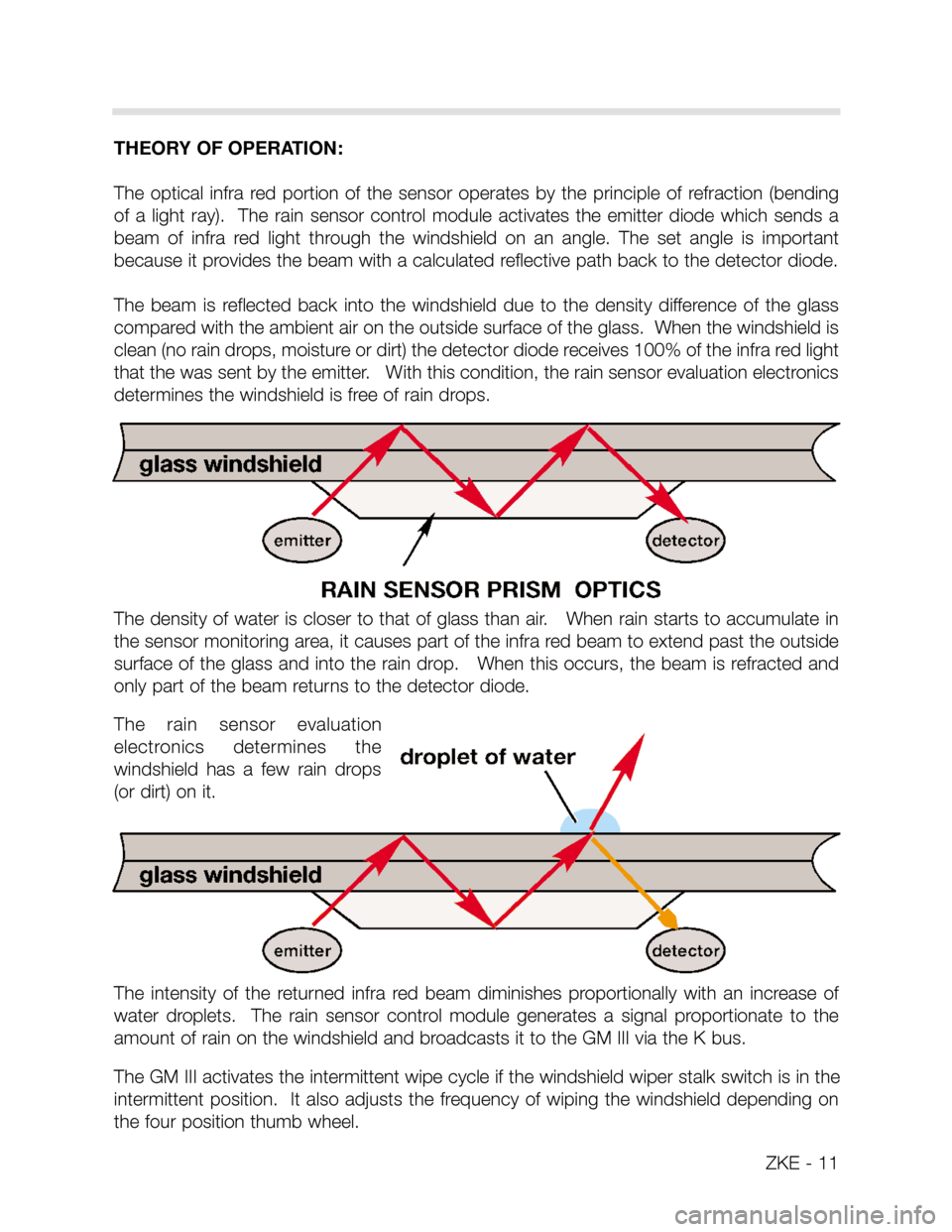
THEORY OF OPERATION:
The optical infra red portion of the sensor operates by the principle of refraction (bending
of a light ray). The rain sensor control module activates the emitter diode which sends a
beam of infra red light through the windshield on an angle. The set angle is important
because it provides the beam with a calculated reflective path back to the detector diode.
The beam is reflected back into the windshield due to the density difference of the glass
compared with the ambient air on the outside surface of the glass. When the windshield is
clean (no rain drops, moisture or dirt) the detector diode receives 100% of the infra red light
that the was sent by the emitter. With this condition, the rain sensor evaluation electronics
determines the windshield is free of rain drops.
The density of water is closer to that of glass than air. When rain starts to accumulate in
the sensor monitoring area, it causes part of the infra red beam to extend past the outside
surface of the glass and into the rain drop. When this occurs, the beam is refracted and
only part of the beam returns to the detector diode.
The rain sensor evaluation
electronics determines the
windshield has a few rain drops
(or dirt) on it.
The intensity of the returned infra red beam diminishes proportionally with an increase of
water droplets. The rain sensor control module generates a signal proportionate to the
amount of rain on the windshield and broadcasts it to the GM III via the K bus.
The GM III activates the intermittent wipe cycle if the windshield wiper stalk switch is in the
intermittent position. It also adjusts the frequency of wiping the windshield depending on
the four position thumb wheel.
ZKE - 11
Page 12 of 64
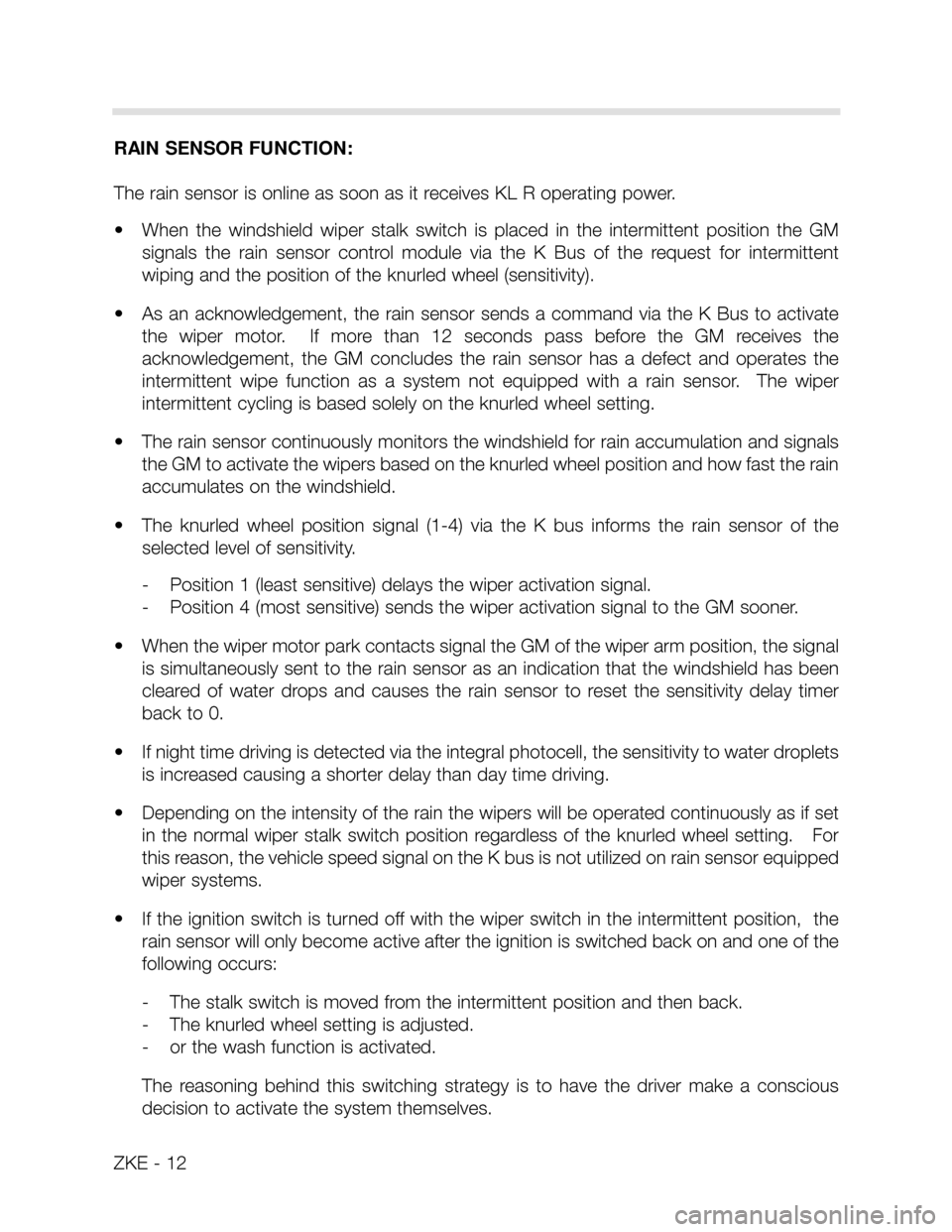
ZKE - 12
RAIN SENSOR FUNCTION:
The rain sensor is online as soon as it receives KL R operating power.
• When the windshield wiper stalk switch is placed in the intermittent position the GM
signals the rain sensor control module via the K Bus of the request for intermittent
wiping and the position of the knurled wheel (sensitivity).
• As an acknowledgement, the rain sensor sends a command via the K Bus to activate
the wiper motor. If more than 12 seconds pass before the GM receives the
acknowledgement, the GM concludes the rain sensor has a defect and operates the
intermittent wipe function as a system not equipped with a rain sensor. The wiper
intermittent cycling is based solely on the knurled wheel setting.
• The rain sensor continuously monitors the windshield for rain accumulation and signals
the GM to activate the wipers based on the knurled wheel position and how fast the rain
accumulates on the windshield.
• The knurled wheel position signal (1-4) via the K bus informs the rain sensor of the
selected level of sensitivity.
- Position 1 (least sensitive) delays the wiper activation signal.
- Position 4 (most sensitive) sends the wiper activation signal to the GM sooner.
• When the wiper motor park contacts signal the GM of the wiper arm position, the signal
is simultaneously sent to the rain sensor as an indication that the windshield has been
cleared of water drops and causes the rain sensor to reset the sensitivity delay timer
back to 0.
• If night time driving is detected via the integral photocell, the sensitivity to water droplets
is increased causing a shorter delay than day time driving.
• Depending on the intensity of the rain the wipers will be operated continuously as if set
in the normal wiper stalk switch position regardless of the knurled wheel setting. For
this reason, the vehicle speed signal on the K bus is not utilized on rain sensor equipped
wiper systems.
• If the ignition switch is turned off with the wiper switch in the intermittent position, the
rain sensor will only become active after the ignition is switched back on and one of the
following occurs:
- The stalk switch is moved from the intermittent position and then back.
- The knurled wheel setting is adjusted.
- or the wash function is activated.
The reasoning behind this switching strategy is to have the driver make a conscious
decision to activate the system themselves.
Page 13 of 64
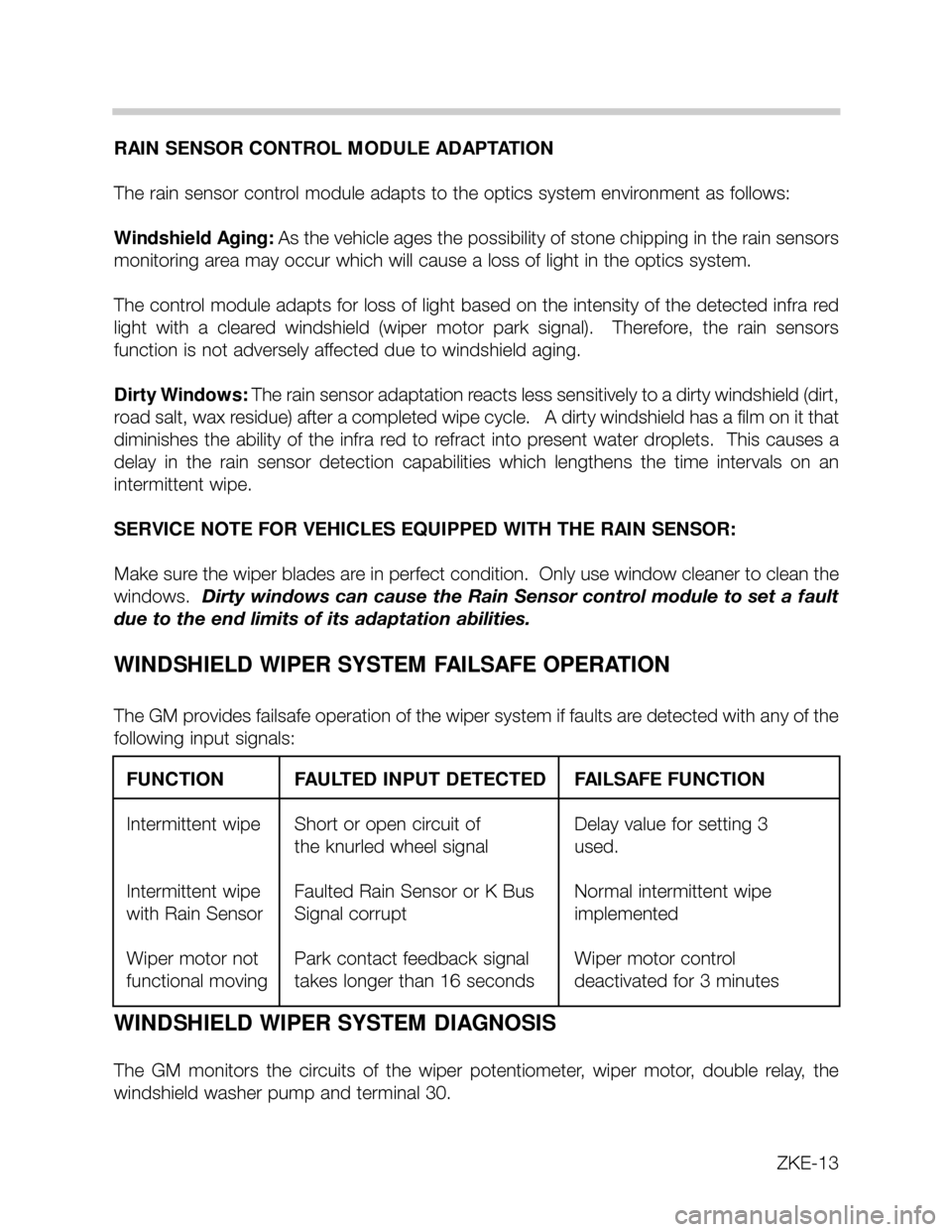
ZKE-13
RAIN SENSOR CONTROL MODULE ADAPTATION
The rain sensor control module adapts to the optics system environment as follows:
Windshield Aging:As the vehicle ages the possibility of stone chipping in the rain sensors
monitoring area may occur which will cause a loss of light in the optics system.
The control module adapts for loss of light based on the intensity of the detected infra red
light with a cleared windshield (wiper motor park signal). Therefore, the rain sensors
function is not adversely affected due to windshield aging.
Dirty Windows:The rain sensor adaptation reacts less sensitively to a dirty windshield (dirt,
road salt, wax residue) after a completed wipe cycle. A dirty windshield has a film on it that
diminishes the ability of the infra red to refract into present water droplets. This causes a
delay in the rain sensor detection capabilities which lengthens the time intervals on an
intermittent wipe.
SERVICE NOTE FOR VEHICLES EQUIPPED WITH THE RAIN SENSOR:
Make sure the wiper blades are in perfect condition. Only use window cleaner to clean the
windows. Dirty windows can cause the Rain Sensor control module to set a fault
due to the end limits of its adaptation abilities.
WINDSHIELD WIPER SYSTEM FAILSAFE OPERATION
The GM provides failsafe operation of the wiper system if faults are detected with any of the
following input signals:
WINDSHIELD WIPER SYSTEM DIAGNOSIS
The GM monitors the circuits of the wiper potentiometer, wiper motor, double relay, the
windshield washer pump and terminal 30.
FUNCTION FAULTED INPUT DETECTED FAILSAFE FUNCTION
Intermittent wipe Short or open circuit of Delay value for setting 3
the knurled wheel signal used.
Intermittent wipe Faulted Rain Sensor or K Bus Normal intermittent wipe
with Rain Sensor Signal corrupt implemented
Wiper motor not Park contact feedback signal Wiper motor control
functional moving takes longer than 16 seconds deactivated for 3 minutes
Page 16 of 64
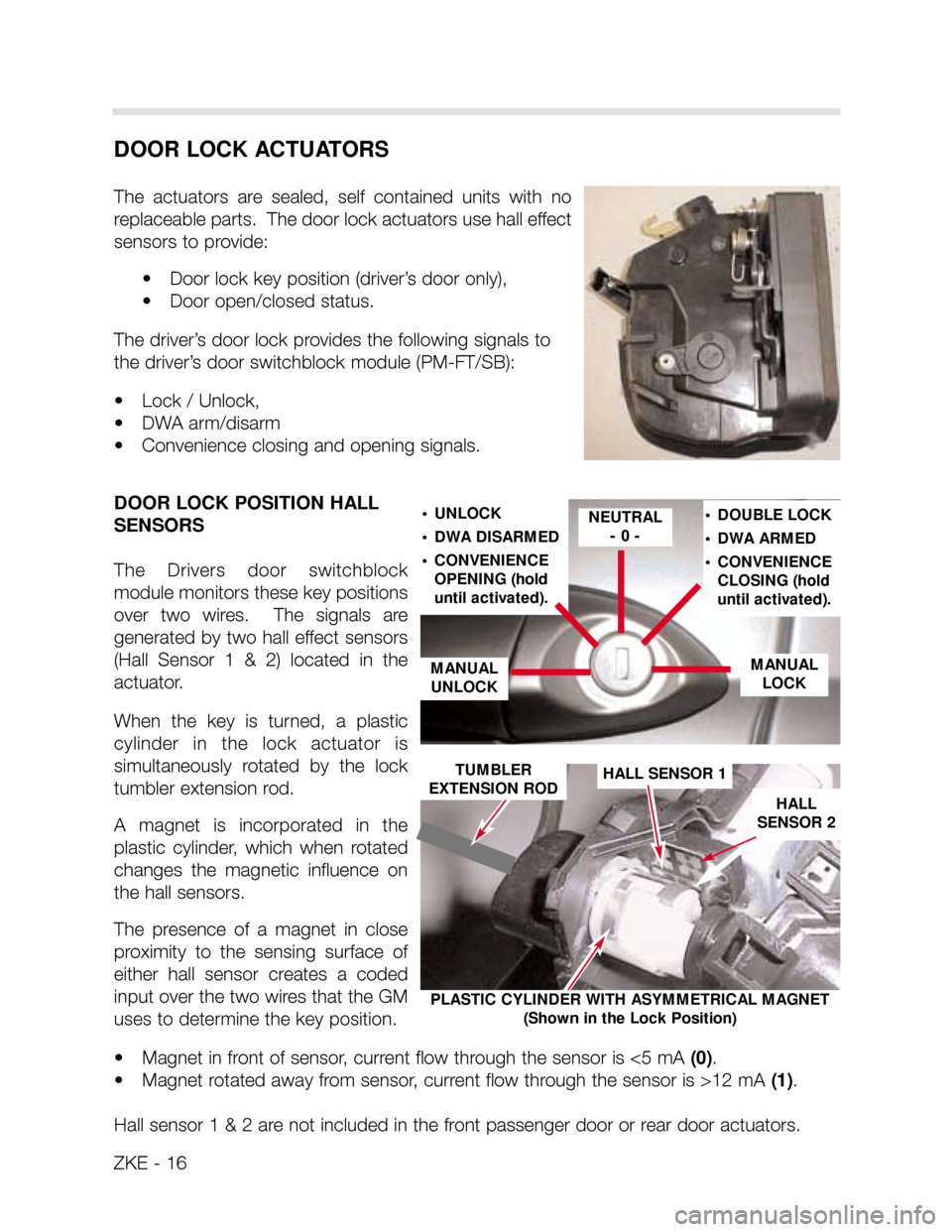
DOOR LOCK ACTUATORS
The actuators are sealed, self contained units with no
replaceable parts. The door lock actuators use hall effect
sensors to provide:
• Door lock key position (driver’s door only),
• Door open/closed status.
The driver’s door lock provides the following signals to
the driver’s door switchblock module (PM-FT/SB):
• Lock / Unlock,
• DWA arm/disarm
• Convenience closing and opening signals.
DOOR LOCK POSITION HALL
SENSORS
The Drivers door switchblock
module monitors these key positions
over two wires. The signals are
generated by two hall effect sensors
(Hall Sensor 1 & 2) located in the
actuator.
When the key is turned, a plastic
cylinder in the lock actuator is
simultaneously rotated by the lock
tumbler extension rod.
A magnet is incorporated in the
plastic cylinder, which when rotated
changes the magnetic influence on
the hall sensors.
The presence of a magnet in close
proximity to the sensing surface of
either hall sensor creates a coded
input over the two wires that the GM
uses to determine the key position.
• Magnet in front of sensor, current flow through the sensor is <5 mA (0).
• Magnet rotated away from sensor, current flow through the sensor is >12 mA (1).
Hall sensor 1 & 2 are not included in the front passenger door or rear door actuators.
ZKE - 16
NEUTRAL
- 0 -
MANUAL
LOCK
HALL SENSOR 1
MANUAL
UNLOCK
• DOUBLE LOCK
DWA ARMED
CONVENIENCE
CLOSING (hold
until activated). UNLOCK
DWA DISARMED
CONVENIENCE
OPENING (hold
until activated).
HALL
SENSOR 2
TUMBLER
EXTENSION ROD
PLASTIC CYLINDER WITH ASYMMETRICAL MAGNET
(Shown in the Lock Position)
Page 17 of 64
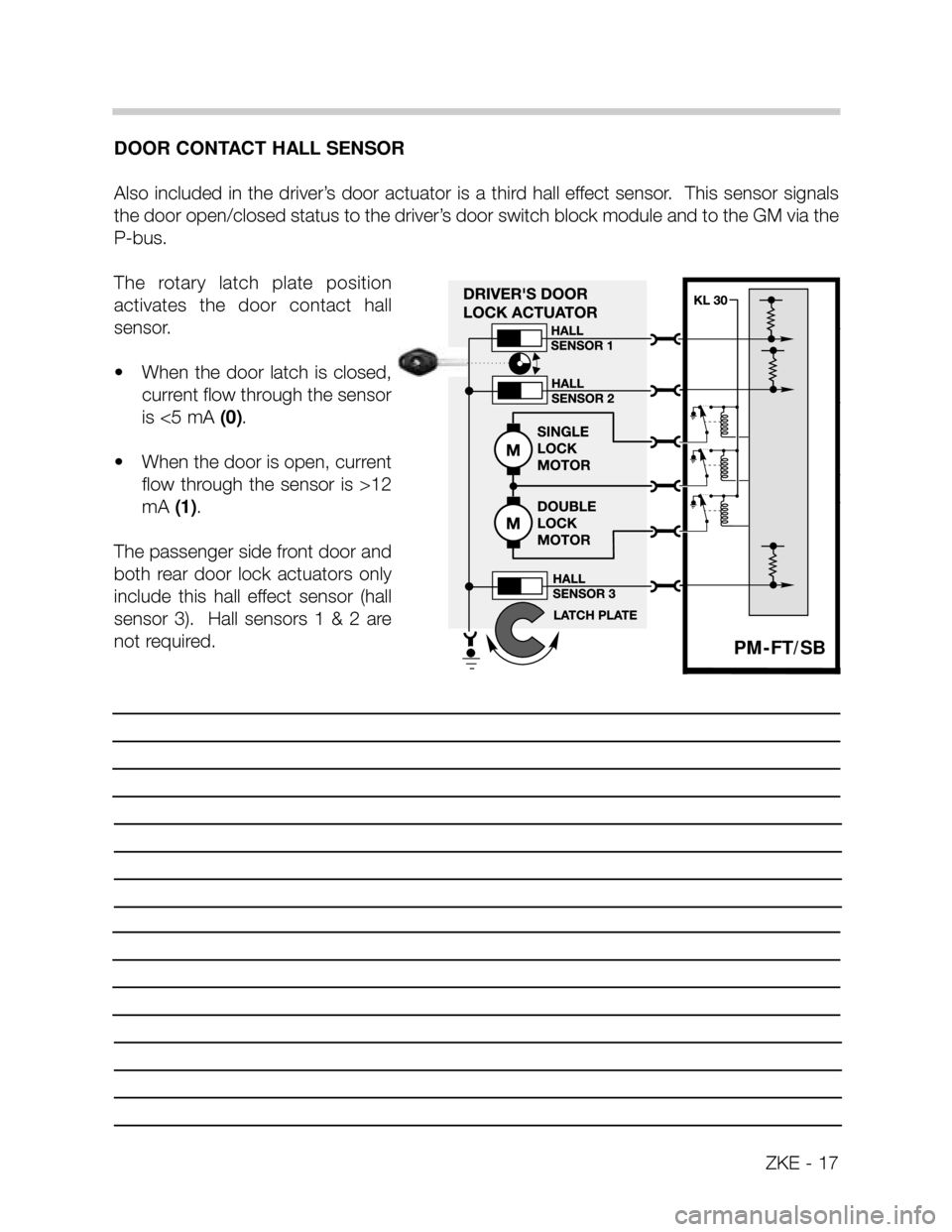
DOOR CONTACT HALL SENSOR
Also included in the driver’s door actuator is a third hall effect sensor. This sensor signals
the door open/closed status to the driver’s door switch block module and to the GM via the
P-bus.
The rotary latch plate position
activates the door contact hall
sensor.
• When the door latch is closed,
current flow through the sensor
is <5 mA (0).
• When the door is open, current
flow through the sensor is >12
mA (1).
The passenger side front door and
both rear door lock actuators only
include this hall effect sensor (hall
sensor 3). Hall sensors 1 & 2 are
not required.
ZKE - 17
PM-FT/SB